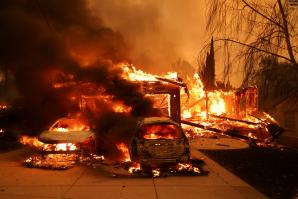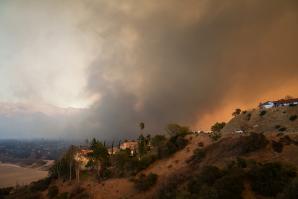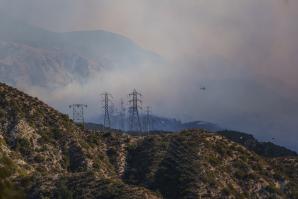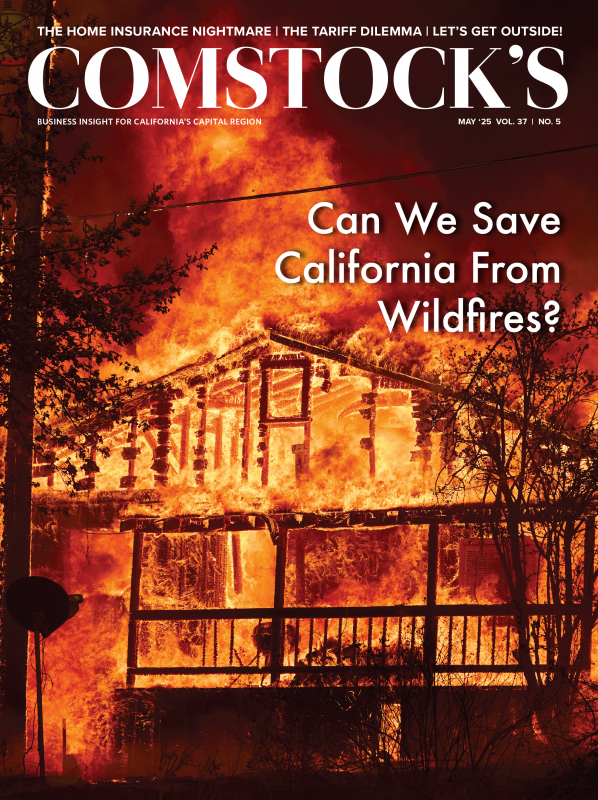Leanne Visser, 56, lives in Arden Arcade, a Sacramento suburb, and seemingly at low risk of being caught in a firestorm. She’s had her house for 21 years and has never filed a home insurance claim. But in July 2024, she got a letter from her insurer threatening to drop her if she didn’t cut branches overhanging her roof. “We’re talking twigs with leaves,” says Visser.
She has an insurance agent friend, Scott Sanchez of Louis Sanchez Insurance Services, and he contacted the insurer to pinpoint what Visser would need to do to keep her policy. Then Visser and a friend with a chainsaw got up on the roof and trimmed. She spent $1,000 to have a tree specialist climb up her big elm. Sanchez sent off photos of the results.
A few weeks later the company told Sanchez they were dropping Visser anyway. “It’s like OK, what was the point?” says Visser.
Keeping a decent insurance plan has only gotten tougher. The re-insurers that backstop companies like State Farm and Farmers are remapping the Capital Region after L.A., say area insurance agents. “They’re looking at Sacramento really harshly right now,” says Sanchez, in part because Cal Fire had previously considered places like Altadena, which burned, relatively low risk. Early reports are that areas that reinsurers hadn’t considered to be in the fire zone now are: Folsom, Roseville, Rocklin, Lincoln and more, he says.
L.A. made an already-bad insurance market worse. For homeowners and businesses lucky enough to have insurance outside the California FAIR Plan, the insurer of last resort, now is the time to sit tight. For those looking for insurance, a few factors — like having a brand-new build and being close to a fire hydrant — will help. But a lot is out of your control.
An unsustainable path
Insurers and consumer advocates argue about who’s to blame. Insurers say the state’s nearly 40-year-old Proposition 103, under which rate increases must be approved by the insurance commissioner, makes it impossible for insurers to charge the rates they need to stay viable. Though California’s home values are far and away the highest of any state, its average homeowners premium of $1,724 ranks 37th of 50.
On the other side are consumer advocates who say insurers have been highly profitable in the country’s largest market and have used the threat of leaving to pressure the state into letting them pad their bottom lines.
All agree that the homeowners market is on an unsustainable path. The number of people forced to turn to the FAIR Plan, a state-mandated fire insurance pool run by California insurers that covers anyone regardless of fire risk — has exploded. The plan’s stability was imperiled before the L.A. disaster: The number of dwelling and commercial policies it underwrote in December 2024 was more than double that of September 2021, and its total portfolio in 2024 was almost 10 times larger than in 2018.
Worse, FAIR Plan policies cost more and have limited coverage, likely leading many owners to go without insurance altogether. A 2023 LendingTree analysis that used census data estimated that more than one in 10 homeowners in Sacramento County and five surrounding counties go bare, meaning they’ll be on the hook in the scenario of total loss.
Jake Ice, principal at Sacramento’s Ice Insurance Agency, says his company no longer writes FAIR Plan policies because of the mistakes he says the plan has made — canceling policies that were paid, not renewing policies that should have been and more. “I don’t need to get sued. They are overwhelmed,” he says.
A new set of rules from California Insurance Commissioner Ricardo Lara, finalized a few days before the L.A. conflagration, was intended to stabilize the market. Those let insurers incorporate forward-looking catastrophe models into their rate setting and pass through some of the cost of reinsurance to consumers, which should make it easier for them to raise premiums to match their risk. In exchange, insurers must cover more homes in wildfire-prone areas.
The outcome of a high-stakes hearing held in early April will be an early indicator of whether the rules will let insurers raise rates more easily. In February, State Farm asked for an emergency 22 percent rate hike on homeowners insurance, citing the billion dollars that it had paid to that point on claims for the L.A. fires.
Lara granted provisional approval but required the company to go before an administrative law judge for a rate hearing, the first time an insurance commissioner has demanded a rate hearing for an emergency request, according to CalMatters.
The L.A. disaster also triggered an emergency bailout of the FAIR Plan: In February, Lara announced that the plan will levy a $1 billion assessment on its member companies. In turn, they’ll pass along half that cost to their customers as a special fee.
It’s not clear how much that will cost individual homeowners or even whether it will be the last assessment, says L.A.-based Douglas Heller, director of insurance at Consumer Federation of America. “I don’t think we can feel really secure about any of these numbers at the moment,” he says. “Except that they’re not going down.”
Lots of losers, a few winners
All that makes buying homeowners insurance in Sacramento increasingly like a lottery. There are three types of insurers: admitted carriers licensed by the state, which offer better coverage and are backed by the state should the company go insolvent; non-admitted carriers that sell coverage with gaps which are usually more expensive and have no state backstop in a bankruptcy; and the FAIR Plan.
The no-go zones where admitted carriers won’t write policies have expanded. Getting insurance on a home with zero fire risk — say, a new home built wildfire-compliant in the middle of Roseville — might get rejected because there’s a brush exposure within 5 miles, says Aurora Mullett, managing partner at Sky Insurance Brokers in Rocklin. Newly blocked-out neighborhoods include those on the American River in Fair Oaks, Orangevale and Carmichael.
Folsom has hit saturation with a lot of companies, so now only two or three are writing policies, mostly non-admitted carriers, says Mullett. Many new homes in Rocklin and Roseville are coming in with very high quotes from admitted carriers or being forced onto the FAIR Plan.
On a low-fire-risk home that Mullett tried to find a policy for recently, she went through 12 companies and couldn’t find a taker, she says. Sanchez says he’s seeing an acceptance rate among admitted carriers that’s likely less than 10 percent. Maggie Bender-Johnson, president and CEO of Bender Insurance Solutions, says major carriers like Travelers and Safeco are clamping down on new business. Her company, one of the region’s largest commercial insurance and surety brokers, is limited to writing one Travelers package per month, she says.
The commercial market is just as bad, especially residential commercial — apartment complexes, homeowners associations, older buildings or properties with any claim history, according to Bender-Johnson. The coverages are getting worse, too, with insurers adding limits for specific types of losses or excluding certain coverages altogether.
Sanchez says companies are more willing to take risks on large commercial buildings, but mid-sized buildings have trouble, and word from the carriers is that no company will write a policy on a building more than 60 years old. And unless buildings are in a downtown urban area, there’s a large wildfire deductible, says Mullett.
Still, a lottery has a few winners. Insurers that have no policies in a particular neighborhood might be willing to issue a few there to diversify their exposure. Last year, Sanchez wrote policies from an admitted carrier on four new million-dollar homes in Auburn with premiums of less than $1,000 a year. But when the neighbors approached him to get the same deal, the insurer declined.
New re-insurer maps complicate the picture. A map might take a year to register that a house in a new development has fire hydrants and a nearby fire department, so a broker can’t write a policy there, says Mullett.
All in all, it’s quite a time to be a California insurance broker. Ice spends a lot of time educating customers and helping them find coverage, even if he doesn’t sell it to them. Climate-driven catastrophes, tariffs and skyrocketing premiums worry him. “Is this kind of (an) out-of-control train on a collision course that could do significant harm to everybody — insurers, agents, brokers, consumers, local economies? It’s scary.”
The lucky ones should sit tight
Neither brokers nor consumer advocate Heller have faith that Lara’s plan will return stability to the market anytime soon.
Mullett says it will be a long time before people in wildfire-prone areas — an increasing portion of the region — get off the FAIR Plan. The Lara rules require companies to write a greater share of their policies in high-wildfire areas but let them increase that share slowly. And forcing State Farm to go to a rate hearing to get its requested emergency increase is a bad sign that it’s not going to get easier for companies to get the hikes they need to cover claims, she says.
On the flip side, Heller says the new rules are too lenient on insurers, which he claims have done well in California historically. He points to industry data showing that in the 26 years covering 1997 to 2022, insurers generated about a 4 percent return selling homeowners insurance in California, versus 2 percent for the country as a whole. But that picture depends on the frame: The same data show companies losing an average of 6 percent a year selling homeowners in California in the 10 years from 2013 to 2022, a period when the rest of the country saw a 3 percent average profit.
Brokers advise those lucky enough to have decent insurance not to give their company a reason to cancel. Pay your premium. Be careful about making claims. Invest in home-hardening against wildfire. If you’re a business, look at captive self-insurance. “This is definitely not a year to shop around based on price,” says Bender-Johnson.
One homeowner in a high-risk area of El Dorado County is investing in a particular kind of self-insurance. Heather Campbell, 63, lives in Pollock Pines and says she pays almost $10,000 a year between car and homeowners insurance.
A former law enforcement officer in the Eldorado National Forest, she’s not sure how much longer she can afford her fire coverage. So she’s put her money into retrofitting her home to ride out a wildfire, investing at least $135,000 over the last 13 years on flame- and ember-resistant eave vents, double-paned tempered windows, a new fire-resistant deck and more.
“I don’t know why it feels so scary to drop insurance coverage,” she says. “But I see it coming sooner than I expected.”
–
Stay up to date on business in the Capital Region: Subscribe to the Comstock’s newsletter today.
Recommended For You

How Is California Fire-Proofing for the Future?
From flame-resistant building materials to increased defensible space, our future homes and neighborhoods may look vastly different
In an era of escalating fire disasters, with insurers fleeing large parts of the state and with builders desperate to find ways to construct houses that would better resist the flames, what can we do to defend our neighborhoods?

Some Burning Questions on Wildfires
FROM THE PUBLISHER: As it is with all catastrophes, there’s plenty of blame to go around. I guess this can be a useful exercise at some point, but it won’t rebuild people’s homes, restore their most valued possessions or, most importantly, stop this from becoming an annual, recurring heartbreak. We need to ask and answer some obvious questions.

Why California Keeps Putting Homes Where Fires Burn
CalMatters: To many ecologists, economists and other experts on California wildfire risk, the vow to rebuild is part of a familiar California cycle as predictable as the Santa Anas: We keep putting homes in the path of the flames.

LA Fires Could Drastically Drive Up Insurance Premiums — and Test California’s New Market Rules
CalMatters: The deadly and destructive fires in Los Angeles — which some say could be the costliest in the state’s history — will further strain the insurance market and worsen the financial position of California’s insurer of last resort.




